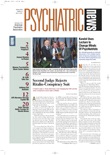Not just serial killers and mass murderers, but all people are capable of committing evil acts. And yes, that includes psychiatrists.
That, at least, is what psychiatrist and psychoanalyst Michael Nelken, M.D., believes. Nelken, who is in private practice in New Haven, Conn., has written a book about one of the big names in evildoing—Adolf Hitler. He made the case for his view at the annual meeting of the American Academy of Psychoanalysis in New Orleans in May, in a talk titled “The Step Into Evil.”
To better appreciate what Nelken had to say, it would probably be a good idea to first make a foray into another talk that was delivered at APA’s 2001 annual meeting in New Orleans only a few days later. This talk, titled “Personality and Evil: Psychiatric Understanding,” was given by Michael Stone, M.D., a professor of clinical psychiatry at Columbia University (
see article above).
Stone has delved into some of the most atrocious acts committed through the centuries in order to better understand what types of people commit them and why they do so. For instance, Stone reported, the typical profile of an evildoer in the U.S. is an individual who is white, male, lower to middle class, and in his 20s or 30s; experienced physical abuse as a child; set fires; and tortured animals. Yet many people who engage in wanton behavior do not fit this profile, he said.
What’s more, he pointed out, those persons who commit heinous behavior are usually not psychotic, and it is rare for a killer to be found legally insane—that is, not to know the difference between right and wrong.
Finally, he pointed out, those individuals who descend into evil behavior often do so in steps, which brings one to Nelken’s talk about “the step into evil.”
Evil, Nelken argued, is actually a spectrum of behavior with good acts on one end and evil acts on the other, and with more neutral behaviors in between. What is crucial, he emphasized, is that “the boundary can shift or be shifted by any of us. We can talk ourselves into things.”
And as if that notion isn’t disturbing enough, Nelken continued, temptations to do wanton things don’t just come now and then, but are ever present. “Impulses to do evil fly thick and fast all day long,” he posited. “Evil is always present, in every mind, but not acted on. This frightens me.”
Yet if a person is battered by evil impulses all day long, what keeps him from acting on them or what prompts him to do so? “I don’t think any of us can answer that,” Nelken admitted. “Even doing psychological autopsies does not give us much predictive power about such moments.”
Nonetheless, he said, he suspects that sometimes just one defining experience might be enough to prompt a person to take the step.
For instance, he pointed out, “up to age 30, Hitler had done nothing bad; then something snapped, and he engineered a Holocaust.” Might any particular experience have served as the trigger? Nelken thinks so. And he believes that it may well have been President Franklin Roosevelt’s 1938 decision not to let European Jews emigrate to the United States. Because of this decision, Nelken asserted, Hitler felt “cornered” by the Jews he so despised and thus decided to get rid of them.
Yet surely psychiatrists and psychoanalysts, who are so sophisticated about the mind, emotions, and behavior, would never be in danger of becoming a Hitler, or even engage in less-atrocious acts. Or would they? Well, probably not, Nelken conceded. After all, he said, “most of us in this room are mostly free of evil. We have good moral compasses; we are thinkers rather than doers.”
And yet. . . .
“Has anyone here killed anyone?” he asked.
To which he hastily added: “Don’t answer that!” ▪
